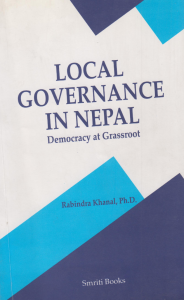-Professor Rabindra Khanal, Kathmandu, Nepal
(Continued from the last issue).
Welfare Approach:
Since the objective of modern state is to facilitate the well being of its people, one may say that a modern state is a welfare state.
The concept of welfare state in the modern period is linked not only with the social security provided by the state but also consists in preparing the citizens to enjoy the rights and freedoms in a democratic manner.
As J. S. Mill says the state which rules the least is the best, because if people are given choices, they are the best judges on government.
A person with full freedom can never go beyond his reasoning.
He has no need to be engaged in activities that are harmful to society. A modern state therefore emphasizes on people’s participation in all the decisions that affect their
life.
Echoing the nineteenth century Poor Laws with their inherent belief that social needs should be satisfied through individual efforts in the market place, administrations dealt largely with crime, delinquency, prostitution, and other forms of “deviant’ behavior. Voluntary charity organizations carried a large share of the burden of social welfare.
Because of the welfare policy’s compatibility with the prevailing development paradigms of modernization, it was continued by quite a few governments of the developing countries on the basis that ‘social welfare institutions should come into play only when the normal structure of supply, family and market, breaks down.
The local government missions in this regard, are the outcome of this approach in society at large and in a particular political system.
Anti-poverty Approach:
Another important approach that can be taken to analyze the scheme of decentralization and local governance is the Anti-poverty Approach.
Nepal is one of the poorest countries of the world and, despite various efforts; the successive governments in this country have not been able to eradicate poverty.
So, the only alternative for development and a better living standard is to give power to the people themselves.
By now it has been widely recognized that modernization theory, with its accelerated growth strategies based on maximizing GDP, has failed either to redistribute income or to solve the problems of Third World poverty and unemployment.
Contrary to the predictions about the positive welfare effects of rapid economic growth, financial benefits have not trickled down to the poor.
As a result, the poor are getting poorer and the rich becoming richer. Looking at this disparity, the World Bank in 1972 officially shifted from its traditional preoccupation with economic growth toward a broader concern with the eradication of absolute poverty and promotion of “redistribution with growth’.

Integral to the approach was the ‘Basic Needs Strategy’, with its primary purpose to meet the basic needs’ such as food, clothing, shelter, fuel, as well as social needs such as education, security, human rights, and participation in social life through employment and political involvement.
Decentralization of power and authority through local governance will enable the people at grassroots to plan development according to their needs.
This will create an environment for them to mobilize the local resources on the basis of local knowledge, especially in a country like Nepal where modern technology is far beyond the ordinary people’s reach.
This would generate a feeling of belonging among the people toward the system and accelerate their participation. People’s involvement in the system certainly make them more aware about their socioeconomic and political life as a result of which they can work harder in improving their life through the means available in their locality.
Majority of the people in any locality are poor and when even a little power comes in their hands, they endeavor to do their best. That is why anti-poverty approach is regarded as one of the best approaches in the study of decentralization and local governance.
Efficiency Approach:
Efficiency is very important in today’s world because of the keen competition in every field.
The increasing globalization of political economy has brought about such a challenge to the nations that they are doomed if they are not efficient in managing the economy.
The fall of Soviet Union in the late 80s is still a fresh evidence for the consequences of inefficiency.
It fell apart mainly due to its inability to cope with the new trends in market mechanism and production.
The Third World countries are suffering heavy stagnation due to the reason.
If they have to survive in this cut-throat competition, they need to build up efficiency right from the grassroots.
Efficiency and productivity, in fact, are the two major objectives of Structural Adjustment Policy (SAP) which is gaining popularity amongst the international aid agencies and national governments alike.
Decentralization and local governance are the main features of this Structural Adjustment Policy which is being adopted by the national governments in order to bring about efficiency in their respective socioeconomic and political systems.
Nepal’s emphasis on decentralization is also guided by the same orientation.
Empowerment Approach :
Empowerment approach is the most recent innovation articulated by the Third World countries.
Its purpose is to empower people through greater participation and self- reliance.
This approach questions some of the fundamental assumptions concerning the interrelationship between power and development.
It acknowledges the importance of the people in increasing their power.
It seeks to identify those who are powerless in terms of degree of domination by others over them and also in terms of their capacity to increase self-reliance and internal strength.
It identifies the rights of people to determine their choices in life and to influence the direction of change through their ability to gain control over crucial material and non-material resources.
People are the main actors in the development process and only their empowerment in the socioeconomic and political fields can bring about the desired results. The importance of people’s empowerment through decentralization and local governance had been clearly defined by the Ninth Plan 1997-2002.
This study attempts to explain the importance of decentralization and local governance in Nepal by emphasizing on the functioning of democracy at grassroots.
The subsequent chapters will deal with the history of decentralization and local governance, the initiatives taken for decentralization after the restoration of multi party system in 1990, the role of decentralization and local governance in the democratization process, and finally the role of political parties in local governance.

CONCEPTUAL FRAMEWORK:
The details obtained from the exploratory studies provide the basis for conceptualizing the impact of local governance in the context of democracy at grassroots.
This conceptual framework is consistent with a more general framework described below.
General Framework:
In a very general sense, the local government institutions are the basic units for people’s participation which is considered to be the prerequisite for democracy.
Participation provides people the opportunity to choose what is best for them.
In other words, people can be a part of the discussion which affects their life.
But mere participation does not fulfill the objectives of democracy.
People’s participation should be supported by power and authority so that they can discuss, decide, and implement decisions authoritatively.
Power and authority provide legitimacy to make their participation meaningful.
The aim of local governance is to empower local people and legitimize their decisions effectively, Decentralization, thus, becomes a fundamental feature of local governance to provide the power and authority to the local people which make their actions legitimate.
In the context of Nepal’s democracy, decentralization and authority need to be studied simultaneously.
Local governance without decentralization is an extension of central bureaucracy when the local people have no real say in the local decision making process.
Even when decentralization is practiced, it is limited to administrative circles.
The authorities of the local bodies were selected by the center and not elected by the people.
All decentralization schemes of the past failed mainly due to the non-involvement of the local people.
With the passage of local government and decentralization laws by the parliament, the people got empowered to take the decisions that affect their life at local levels.
Their political rights are established through the method of election.
They can make the plans and policies for their development.
The structures of local bodies were set up and the power, authority, and space of their functions were defined. The subsequent bi laws should determine the success or failure of local governance in Nepal.
Decentralization and Grassroots Democracy:
Democracy at grassroots can thrive only when people have adequate power and authority in taking major decisions.
They should be able to make the plans, implement them, and evaluate the implementation by themselves.
But, to be able to do all these things, they need power and authority and be duly recognized by the higher authorities.
In most democratic countries, people realize that power and authority need not be given from above, but can be derived from the people democratically.
Decentralization, in this context, is a legitimate mechanism that can empower the local bodies and the people to function independently in implementing the fundamentals of democracy at grassroots.
But, what is decentralization? A definition of decentralization commonly used is the one from Chemma and Rondinelli, which says:
… the transfer of planning, decision making or administrative authority from the central government to its field organizations, local administrative units, semi-autonomous and parastatal organizations, local governments, or non-governmental organizations.”
This broad definition includes almost all the aspects including political, administrative, and economic decentralization.
This definition, however, has focused more on vertical decentralization which is a corollary to the need of this study.
At the same time, it also recognizes the role of non-governmental organizations in the decentralization process.
In development literature, vertical decentralization has been dealt with in three ways:
Deconcentration:
Deconcentration can be defined as the transfer of power and function from the central level government organizations to their respective field level agencies enabling the latter to carry out their tasks efficiently and effectively.
Kirsten says that deconcentration is the process of redistribution of administrative responsibilities within the central government, which might be used to consolidate the central government’s power through field offices.
For Maddick, Deconcentration is “the delegation of authority adequate for the discharge of specified function to staff of a central department, who is situated outside the headquarters”.
Rondinelli holds a similar view and states it “merely involves the shifting of workload from central government ministry headquarters to the staff located in the offices outside of the national capital”.
Deconcentration, however, does not allow the local units the freedom of decision making.
The deconcentrated agencies need to get the consent of the central authority in making all kinds of decisions, but make it easier for the local people because they do not have to go to the center for everything.
The relationship between the central and local units is based on the hierarchy and can contribute very little to the promotion of local democracy.
In fact, the deconcentrated agencies are only the bureaucratic arms of the central government and do not actually help in strengthening local governance.
# Text courtesy: From the book “Local Governance in Nepal, Democracy at Grass root” published by the Smriti Books ( 2006) and authored by Professor Rabindra Khanal.
# Thanks to the distinguished Professor R. Khanal and the Smriti Books: Upadhyaya. N. P.
# Our contact email address is: editor.telegraphnepal@gmail.com
# To be concluded.

